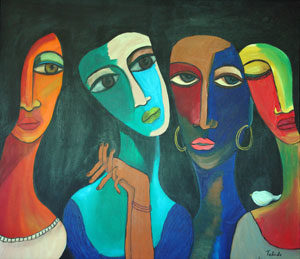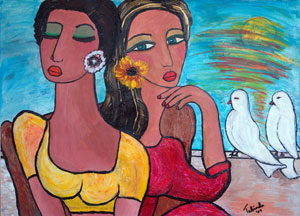The Art of Living
By Hawra Harianawala | Art | Arts & Culture | Published 14 years ago
 What is art if not a reflection of self? How much can one tell of a person from viewing their artwork? Being a student of psychology and a visual artist, I find myself creating a mental sketch of the artist’s personality whilst viewing his/her work. And Tabinda Chinoy’s vivid creations have a vast vocabulary all their own.
What is art if not a reflection of self? How much can one tell of a person from viewing their artwork? Being a student of psychology and a visual artist, I find myself creating a mental sketch of the artist’s personality whilst viewing his/her work. And Tabinda Chinoy’s vivid creations have a vast vocabulary all their own.
Her latest body of work comprises mainly of the human form draped across telling landscapes, laden with symbolism to convey her message in each piece. Her canvases range in size, but the subject matter is mostly bold, stylised portraits with wide expressive eyes. In some of her work, an amalgamation of all the cultures and different mediums of art she has been exposed to, she uses architectural references to convey the ‘live and let live’ philosophy she adheres to, which transcends boundaries of national borders and ideologies. Certainly, even at first glance, her work conveys an open, uninhibited quality that is reflective of both her multicultural exposure and her beliefs.
For all its expansiveness, Tabinda’s work is not that of an escapist: it conveys through symbols and mood societal double standards and schisms. But also present are birds and blue skies to symbolise hope. In most of her work, the artist depicts light at the end of every dark tunnel, be it an individual’s personal journey or that of society at large. One of her works shows a tree bearing a lone leaf with a woman seated under its bare form — a way of saying that all is never lost, there is always something to be salvaged and some glimmer of light in the future.
 While Tabinda cites her father — a ‘hobby painter’ and ‘art enthusiast’ — as the source of her inspiration and the development of her aesthetic sense, she is one of the lucky few local artists to have had Ali Imam as a teacher and then having painted alongside artists like Bashir Mirza.
While Tabinda cites her father — a ‘hobby painter’ and ‘art enthusiast’ — as the source of her inspiration and the development of her aesthetic sense, she is one of the lucky few local artists to have had Ali Imam as a teacher and then having painted alongside artists like Bashir Mirza.
Perhaps because of her own remarkably happy journey as an artist, Tabinda feels it is important to give back. Thus, she has often used her art for social causes like creating awareness about abuse in rural areas and donating paintings for auction for flood victims or the terminally ill.
Tabinda is showing her work at Canvas in April — a post-expressionistic gala of colour and an imagination run riot, coupled with a decided opinion in each piece.


